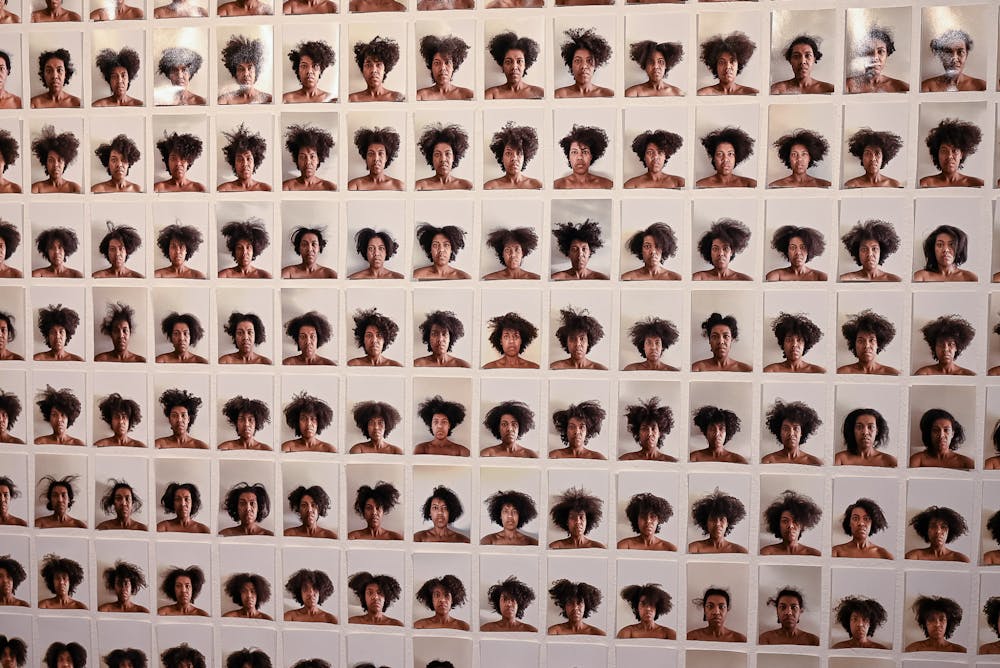"Getting to the Root" is an art exhibition curated by Amber C. Coleman, Jazmine Beatty, Tehan Ketema and Olivia Richardson, focusing on Black hair culture and the social perceptions surrounding Black culture. The exhibition, in collaboration with several artists across the U.S., is open from Feb. 4 to March 7 at the Harry Wood Gallery inside the ASU School of Art.
Amber C. Coleman, an ASU postdoctoral scholar and one of the creators of the exhibit, said co-curator Jasmine Beatty conceptualized the idea of a theoretical exhibition that focused on Black hair culture throughout her research. The four decided to bring the theoretical exhibition to life.
Coleman said the curators applied and were awarded a grant from the Herberger Institute for Design and the Arts to fund the exhibition.
She said because the curators live across the U.S., the exhibition is meant to travel to various cities, starting with Tempe and possibly traveling to Madison, Wisconsin next.
The exhibition being located at a university creates a unique opportunity to bring different groups of people together, Coleman said.
Coleman emphasized the significance of the exhibition being shown at ASU, a renowned research institution. "It's important to see those connections we can create something that is connected to research, that's connected to everyday life," Coleman said.
The curators held an open call for artists whose work centered around topics such as Black hair and culture. As the exhibition travels, Coleman said the curators hope to include local artists into the space.
"We're hoping that each time we have the exhibition that it will include some local voices of artists that will be a part of the exhibition," Coleman said.
Ajanaé Dawkins, an artist featured in the exhibition, said she was excited to contribute and bring in art that focused on the relationship between Black women.
"I was excited to contribute to a conversation about Black hair but in a way that was not just necessarily meditating on the beauty of Black hair, but thinking about Black hair as a cultural tradition and as one that is, in a lot of ways, kind of bonding," Dawkins said.
Dawkins contributed a short film titled "Where Black Girls Go" and a physical installation titled "My Sisters."
The short film "Where Black Girls Go," created alongside filmmaker Matthew Pitts and creative consultant Iyana Hill, was centered around Dawkins' personal connection to the subject of missing Black women because of her aunt who went missing, Dawkins said.
"I can't imagine her in heaven and so I decided to imagine her on Mars," Dawkins said. "I was fixated on this image of a woman on Mars making attempts to describe to aliens her very Black beauty rituals."
In her art piece, "My Sisters," Dawkins said she focused on Black women who experienced various types of violence or were missing and how they are portrayed in media.
Dawkins said she thinks of women, whether she knows them or not, as sisters "connected by a kind of sociopolitical experience."
Alisa Hardy, an artist featured in the exhibition, said she connected with the exhibition's message because of her own journey with her hair.
"To find an exhibit centered around such a subject, it just touched me so much because I remember growing up (and) there weren't a lot of hair products for coily or curly hair," Hardy said. "To be part of something that celebrates my hair journey in a way — it really healed a part of my inner child. I think it was just such an amazing opportunity."
Hardy said she has been working on her "Cloud Hair" series for two years, which focuses on storytelling through different types of hairstyles. She contributed three pieces to the exhibition, titled "Cloud Hair Self Portraits," "Bubble Braids" and "Boxed Braids with Clouds."
Hardy said she hopes her work brings an awareness to different types of hair and moves way from the typical standard for beauty.
"The standard of beauty — has been for a long time — straight blonde hair, so to kind of change the narrative from 'a certain type of hair is beautiful' to 'all hair types are beautiful,'" Hardy said. "Getting back to our roots when it comes to hair is really important as just knowing where you come from but also others understanding each other."
Coleman said she hopes that the exhibition sparks conversations for people who visit it and that they feel connected to the art.
"It is important to show how this is something that is widely applicable to people's everyday lives," Coleman said. "This is something that has an everyday impact, but also that something can be created out of something that is so ordinary or something that is a part of our everyday lives."
Edited by Senna James, Abigail Beck, Tiya Talwar and Natalia Jarrett.
Reach the reporter at alillest@asu.edu and follow @allylillestol on X.
Like The State Press on Facebook and follow @statepress on X.
Allison is a sophomore studying journalism and mass communication. This is her first semester at The State Press. She has also worked at Arizona PBS and Blaze Radio.






